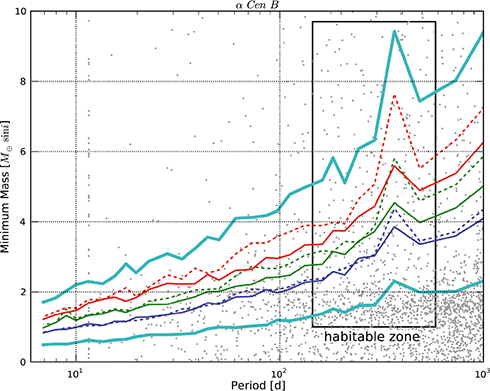 CAUP Researchers: Xavier Dumusque, Nuno C. Santos, Mário J. P. F. G. Monteiro Planetary detection limits taking into account stellar noise Planetary detection limits taking into account stellar noise The radial-velocity technique is at present the most efficient method to detect exoplanets. The technique is now reaching the sub-meter-per-second level with the HARPS spectrograph, which allows us to detect super-Earth (M < 10 M⊕) mass planets. The main problem with this method is that one has to assure that the radial-velocity variations observed are caused by a low mass companion. Phenomena such as stellar pulsation, granulation, or activity related features can actually impose significant limitations to the detection of planets, in particular those in low-mass and long period orbits like our Earth. Without a good understanding of stellar noise, it will thus be very difficult to detect very low mass planets even if the instrumental precision reaches levels of a few centimeters-per-second. A team of astronomers lead by CAUP members published a series of papers where they explore the best observing strategy to avoid or significantly reduce the stellar noise perturbation. They have used data for different stars obtained with the HARPS spectrograph, as well as solar activity data, to understand the timescales of the stellar phenomena that can induce "noise" in the radial velocity data. Having these figures, they checked what was the best observing strategy that would allow averaging out this "noise", bringing the radial velocity precision close to the instrumental level of noise. Finally, using this strategy they estimated the mass of planets that can be detected with present and future high precision radial velocity instruments.
Although the radial-velocity technique has already proven its proficiency in finding exoplanets, it still faces considerable limitations that prevent the detection of earth-like planets. While the limitations related to instrumental capabilities are now being overcome, with instruments like HARPS, or, in the future, ESPRESSO and CODEX, several other limitations related to stellar atmosphere phenomena still need to be tackled. In particular, the current accuracy levels of about ~100 cm s-1, are already so low that stellar noise (i.e., oscillations, granulation, and magnetic activity) can lead researchers to failure in detecting existing exoplanets or even lead to the detection of non-existing planets. In early 2010, a team lead by CAUP members had already published a paper [1] presenting the results of long-term observation of K dwarf stars. This allowed them to conclude that long-term variations of stellar activity should not be a significant problem hindering the detection of low-mass exoplanets, at least for K-dwarfs; furthermore, they found that such activity could be accurately traced with the Ca II “S“ activity index. Now, with the two papers highlighted here, this team determined the best observational strategies to reduce the effect of stellar oscillations, granulation and spot groups. In paper I., they used precise HARPS asteroseismic measurements of 5 stars over periods between 5 and 8 days, and determined which observational strategy would better average out the signal induced by granulation and oscillation modes. The best observational strategy found consisted of performing three measurements per night of 10 minutes each and 2 hours apart from each other, for a total of 10 consecutive days. These results, however, did not include phenomena with timescales longer than 5-8 days, as is the case for spot groups. Thus, in paper II., this problem was dealt with by using observations of sunspots. The team simulated the radial velocity signal that would be induced by sun-like groups of spots, for different activity levels; the evolution of spot groups over time was also considered in these simulations. Then, three observational strategies were simulated and the one found to better average out all kinds of stellar noise consists of observing the star three times per night, each observation being 10 minutes long and 2h apart from the previous one; this procedure should be repeated every third night for a total of 10 days every month. The detection limits of the different strategies were also determined (Fig. 1) for HARPS and ESPRESSO. The best observational strategy is expected to allow ESPRESSO to reach a detection limit of 1.3 M⊕ in the habitable region of early K-dwarfs. These highlighted papers were written as part of the Ph.D. project of Xavier Dumusque who, thus, provided the major contribution to this work. [1] N. C. Santos, João N. T. Gomes da Silva, C. Lovis, C. Melo, Do stellar magnetic cycles influence the measurement of precise radial velocities?, Astronomy and Astrophysics, Volume 511, A54 (2010) |






















